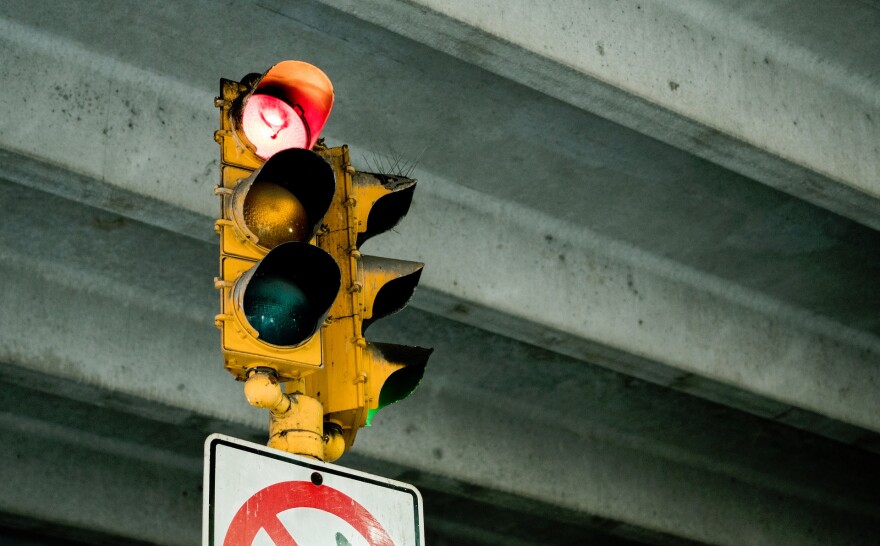Editor's Note: A version of this episode was originally published June 18, 2019.
We all know the feeling. You're in a rush on your way to work or to drop the kids off, and you end up hitting back-to-back-to-back red lights. Your blood pressure kicks up, your body tenses and your brain screams, "Let's go! Turn green already!"
It's more than just an everyday annoyance. Excessive red lights cost drivers time and gas, and can encourage risky driving habits like speeding to make it through the next intersection.
"Some days I literally come to a stop at every single traffic light, which is kind of annoying," said WFAE listener Christine Thomas, whose morning commute pre-pandemic took her down Mint Street in uptown Charlotte.
She asked FAQ City whether Charlotte has a traffic-timing system, and if so, why did she hit so many red lights on Mint Street, and could the city better coordinate them to keep traffic flowing?
Three types of signals
To find out whether a traffic signal is malfunctioning, Charlotte's transportation systems manager, Nathan Conard, said first it's important to determine what kind of signal it is. Conard said there are three possibilities:
- Wire (Inductor) Loop: At these intersections, thin wires have been embedded in the pavement, usually in a rectangular shape. They sense when metal passes overhead (like a car) and tell the traffic light to stay green until all the cars have passed, or until the light maxes out on time. Of Charlotte's 840 traffic signals, about 60% are on a wire loop. But these signals can't always detect motorcycles or bicycles and can struggle to detect traffic if the pavement deteriorates or becomes uneven.
- Camera Controlled: Ever seen a video camera perched above or near a traffic light? It's not a red light camera (Charlotte scrapped those in 2006); it's there to help the traffic signal. It works just the same as a wire loop, but the cameras visually detect vehicles and instruct the light to stay green until the lane is clear. About 40% of the city's traffic lights are camera equipped. Generally they work well, but can have issues with fog, glare from the sun, and low-light conditions.
- Fixed Loop: The third type of traffic light is not controlled by cameras or wires, but instead runs on a timer with a preset loop. These only make up about 10% of the city's traffic lights.
Time of day
Once you have determined the type of traffic signal where you're getting stuck — and you can safely say it's not because of a faulty wire or camera —consider the time of day you're driving. Conard said nearly every traffic signal in Charlotte runs on four pre-determined traffic patterns: morning rush, midday, afternoon rush, and overnight.
Sometimes, when the lights are switching from one pattern to the next, they get out of sync.
"Sometimes it's really quick. Sometimes it's less than a cycle," Conard said. "But sometimes it takes a couple cycles for the intersections to get back in sync with each other."
If you're hitting a lot of red lights at 6 a.m., the intersections might be transitioning from overnight to morning rush — and you're driving at the exact wrong time.
If nothing else ...
In Thomas' case, a test drive down Mint Street during the 7 a.m. morning rush turned up a mixed bag of evidence. Only two of the six intersections had cameras, and none appeared to have wire loops. The skies were sunny and clear, ruling out the possibility that the cameras couldn't see well, and the traffic lights had already switched from overnight to morning rush about an hour before Thomas buckled her seatbelt and put the car in gear.
If equipment and time of day aren't the problem, then the poorly timed signals are likely connected to the preset traffic pattern. Getting those patterns right is a major part of a traffic engineer's job, and one of the most difficult. In a perfect world, everyone would always get a green light, but that can't always happen — especially not in areas with lots of intersecting streets.
"We're not always going to be able to progress every direction of every street and that's beyond signal timing," Conard said. "That's just physics."
Improving traffic flow
There are opportunities to make things better. The city of Charlotte could invest in more cameras and wires at those uptown intersections, and engineers can always fine-tune traffic patterns. But Conard said the city can't fix what it doesn't know is broken.
He said the best way for residents like Thomas to alert the city of a frustrating series of traffic signals is to dial 311, press 5 for "other city services," and let the operator know what intersection is causing problems and the time of day they're driving. Residents can also submit requests for traffic signal "timing evaluations" on the Charlotte Department of Transportation's website.
DOT workers review every complaint and if an intersection has a particularly bad reputation, they'll send an engineer out to investigate. The agency also said it retimes every intersection, even without a complaint, every two years to keep up with Charlotte's growing population and ever-changing traffic patterns.
_




